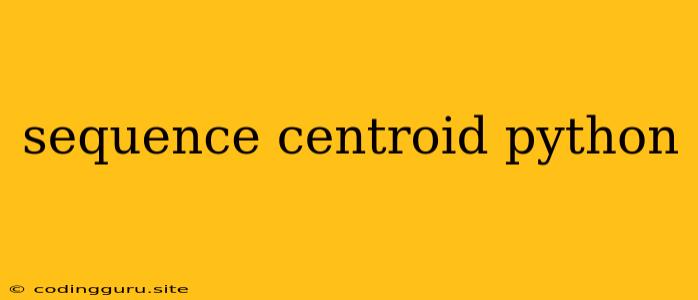Unlocking the Power of Centroids: A Deep Dive into Sequence Centroids in Python
The concept of a centroid is a fundamental tool in data analysis, and its application extends beyond traditional geometric shapes. In the realm of sequence analysis, the centroid takes on a new meaning, representing a central or average sequence within a dataset. This powerful concept has a wide range of applications, from understanding evolutionary patterns to identifying representative sequences in bioinformatics, and even in natural language processing.
But how do we actually calculate and utilize a sequence centroid? This is where Python comes into play, providing a versatile and efficient environment for manipulating and analyzing sequences.
What are Sequence Centroids?
A sequence centroid is a representative sequence that summarizes the central tendency of a set of sequences. Imagine having a collection of DNA sequences; a sequence centroid would be a hypothetical sequence that captures the average characteristics of those sequences.
Why Are Sequence Centroids Important?
Sequence centroids are essential tools for several reasons:
- Data Reduction: They allow you to represent a large dataset of sequences with a single, representative sequence.
- Clustering and Classification: They are used for grouping similar sequences together, facilitating analysis and understanding.
- Alignment and Comparison: By comparing sequences to a centroid, you can assess their similarity and divergence from the central tendency.
Calculating Sequence Centroids: A Python Approach
Python offers several libraries and approaches to calculate sequence centroids. Here's a breakdown of common methods:
1. Using Biopython:
The Biopython library provides a powerful and convenient way to work with biological sequences. It offers the Bio.Align.AlignInfo module, which includes the summary_align function for generating a consensus sequence.
Example:
from Bio import AlignIO
from Bio.Align import AlignInfo
# Load your alignment file (e.g., in FASTA format)
alignment = AlignIO.read("your_alignment.fasta", "fasta")
# Create an AlignInfo object
summary_align = AlignInfo.SummaryInfo(alignment)
# Calculate the consensus sequence (centroid)
consensus_sequence = summary_align.gap_consensus(threshold=0.5)
# Print the consensus sequence
print(consensus_sequence)
2. Custom Implementation:
You can also create a custom function to calculate the centroid based on your specific requirements. This approach gives you full control over the algorithm used.
Example:
def calculate_sequence_centroid(sequences):
"""
Calculates the centroid of a set of sequences.
Args:
sequences (list): A list of sequences.
Returns:
str: The calculated centroid sequence.
"""
# Initialize an empty centroid sequence
centroid = ""
# Iterate over each position in the sequences
for i in range(len(sequences[0])):
# Create a list of characters at the current position
characters = [seq[i] for seq in sequences]
# Find the most frequent character
most_frequent = max(set(characters), key=characters.count)
# Append the most frequent character to the centroid
centroid += most_frequent
return centroid
# Example usage
sequences = ["ACGT", "AGCT", "AGGT"]
centroid = calculate_sequence_centroid(sequences)
print(centroid)
This custom function iterates over each position in the sequences, identifies the most frequent character at each position, and constructs the centroid sequence accordingly.
Applications of Sequence Centroids in Bioinformatics:
Sequence centroids have a wide range of applications in bioinformatics:
- Phylogenetic Analysis: Determining the evolutionary relationships between different species or strains by comparing their sequence centroids.
- Gene Expression Analysis: Identifying differentially expressed genes based on the changes in their corresponding sequence centroids in different conditions.
- Drug Discovery: Analyzing sequence centroids of protein targets to identify potential drug candidates that bind to the central tendency of the target proteins.
Tips for Utilizing Sequence Centroids Effectively:
- Choose the Right Algorithm: The method of calculating the sequence centroid depends on the specific type of sequence data and the intended application.
- Handling Gaps and Indels: When working with sequence alignments, it's important to consider how gaps and insertions/deletions are treated when calculating the centroid.
- Evaluate the Result: Always evaluate the relevance and interpretability of the centroid sequence in the context of your research question.
Conclusion:
Sequence centroids are powerful tools for summarizing, analyzing, and comparing sequence data. Python provides a robust and versatile environment for calculating and utilizing sequence centroids, enabling researchers to explore and understand complex biological data. By leveraging Python's libraries and implementing custom algorithms, you can effectively harness the power of sequence centroids for a wide range of bioinformatics applications.
